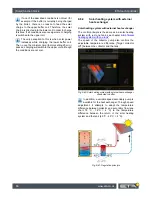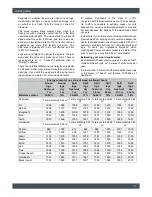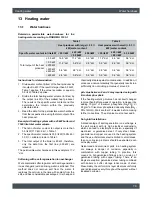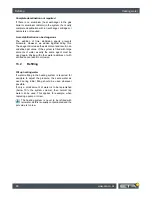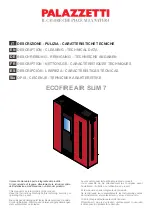
Heating water
Water hardness
79
13 Heating water
13.1
Water hardness
Determine permissible water hardness for the
heating water according to ÖNORM H 5195-1
Instructions for determination:
1. Divide water content (litres) of the heat producer by
its output in kW. If the result is larger than 0.3 l/kW,
Table 1 applies. If the value is smaller or equal to
0.3 l/kW, Table 2 applies.
2. Divide the total heating water volume (in litres) by
the output (in kW) of the smallest heat producer.
The result is the specific water content and this
determines the column within the previously
calculated table.
3. Read the data for the permissible water hardness
from the respective line using the total output of the
heat producer.
Example: A heating system with a 45 kW boiler and
1500 litre total water volume.
1. The ratio of water content to output is more than
0.3 l/kW (117:45=2.6) => Table 1.
2. The specific water content is 33,3 l/kW (1500÷45 =
33.3) => middle column in Table 1.
3. The total output of the boiler is 45 kW; therefore,
only the data from the first line (
≤
50 kW) are
relevant.
The permissible water hardness in this example is 11.2
°dH.
Softening with a salt-regeneration ion exchanger
We recommend softening water with salt-regeneration
ion exchangers, just as drinking water is softened. This
method does not remove salt from the water. It
replaces the calcium in the lime with sodium from the
salt, and has considerable advantages. It is cheap and
chemically stable against contamination. In addition, it
produces a natural alkalinity that generally results in a
sufficiently non-corroding pH value of around 8.
pH value between 8 and 9 may require dosing with
trisodium phosphate
If the heating water's pH value has not itself changed
to more than 8 after a week of operation, increase it by
adding 10 g/m³ of trisodium phosphate (Na
3
PO
4
) or
25 g/m³ of trisodium phosphate dodecahydrate (Na
3
-
PO
4
.12H
2
O). Wait another 2-4 weeks before making
further corrections. The pH value must not exceed 9.
No hybrid installations
A disadvantage of salt-regeneration ion exchange is
the salt content with its high electrical conductivity,
which can lead to electrolytic corrosion, especially of
aluminium or galvanized steel. If only steel, brass,
gunmetal and copper are used in the heating system
and the use of stainless steel is limited to small areas,
then no corrosion problems should be expected, even
with salty water.
Galvanized and aluminium parts in a heating system
are always in danger of corrosion, especially in
combination with copper tubing. In practice, this
means no hot-galvanized fittings and no mixing of
galvanized tubing with copper tubing. There is an
illogical exception: galvanized steel tubing combined
with boilers or buffer storage tanks made of steel.
Presumably, the uniform zinc layer dissolves uniformly
and is dispersed evenly throughout the system without
localised corrosion.
Table 1
Heat producer with large (> 0.3 l/
kW) water content
Table 2
Heat producer with small (> 0.3 l/
kW) water content
Specific water content in litre/kW
< 20 l/kW
≥
20 /kW
< 50 l/kW
≥
50 l/kW
< 20 l/kW
≥
20 l/kW
< 50 l/kW
≥
50 l/kW
Total output of the heat
producer
≤
50 kW
16.8 °dH
11.2 °dH
5.6 °dH
11.2 °dH
5.6 °dH
0.6 °dH
> 50 kW
≤
200 kW
11.2 °dH
5.6 °dH
2.8 °dH
5.6 °dH
2.8 °dH
0.6 °dH
> 200 kW
≤
600 kW
5.6 °dH
2.8 °dH
0.6 °dH
2.8 °dH
0.6 °dH
0.6 °dH
> 600 kW
2.8 °dH
0.6 °dH
0.6 °dH
0.6 °dH
0.6 °dH
0.6 °dH
Содержание TWIN 20 kW
Страница 1: ...2016 04 02 EN 0000000302 V 001 X 36 0 2303 93412 001 TWIN pellet burner 20 26 kW Operation ...
Страница 39: ...ETAtouch controller TWIN function block 39 ...
Страница 49: ...ETAtouch controller Buffer function block 49 ...
Страница 53: ...ETAtouch controller Hot water tank function block 53 ...
Страница 57: ...ETAtouch controller Fresh water module function block 57 ...
Страница 81: ......
Страница 82: ...www eta co at ...
Страница 83: ......
Страница 84: ...www eta co at ...




